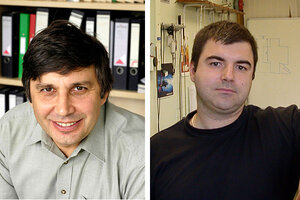Konstantin Novoselov and Andre Geim get Nobel Prize for super-strong graphene
Nobel Prize winners Andre Geim and Konstantin Novoselov were recognized today for their work with one-atom thick carbon known as graphene. The Nobel Prize committee recognized their "playfulness."

Russian-born scientists Andre Geim and Konstantin Novoselov shared the Nobel Prize in physics Tuesday for "groundbreaking experiments" with an atom-thin material expected to play a large role in electronics.
University of Manchester/AP
Stockholm, Sweden
Two Russian-born scientists shared the 2010 Nobel Prize for physics for showing how carbon just one atom thick behaved, a discovery with profound implications from quantum physics to consumer electronics.
Andre Geim and Konstantin Novoselov of the University of Manchester conducted experiments with graphene. One hundred times stronger than steel, it is a new form of carbon that is both the thinnest and toughest material known.
"Since it is practically transparent and a good conductor, graphene is suitable for producing transparent touch screens, light panels, and maybe even solar cells," the committee said.
Novoselov, 36, is a dual British-Russian citizen while Geim, 51, is a Dutch citizen. A committee official said Novoselov was the youngest physics laureate since 1973.
Geim, speaking at a Nobel news conference via telephone, said he had not expected the prize and would try not to let the news change his routine.
"My plan for today is to go to work and finish up a paper that I didn't finish this week," he said. "I just try to muddle on as before."
The pair extracted the material from a piece of graphite such as that found in ordinary pencils using adhesive tape, repeating the tape-trick until they were left with miniscule flakes of graphene.
The normally sober-sounding academy celebrated the "playfulness" that the two scientists exhibited.
Geim especially does not mind injecting humour into science. In 1997 he levitated a frog using a magnetic field, winning himself a tongue-in-cheek "IgNobel Award" from the Annals of Improbable Research in 2000.
"I think I'm the first person who won both. I'm very proud of these prizes," he said.
Mark Miodownik, head of a research unit at King's College London, said the award will bring a smile to the face of every scientist. "It shows you can still get a Nobel Prize by mucking about in a lab."
QUANTUM LEAP
One millimetre of graphite consists of 3 million layers of graphene stacked on top of each other but held together weakly.
"Anyone who has written something with an ordinary pencil has experienced this, and it is possible, when they did, that only a single layer of atoms, graphene, happened to end up on the paper." The material is almost completely transparent yet so dense that not even the smallest gas atom can pass through it. It also conducts electricity as well as copper.
"It's a material that has enormous special properties. It's a big crystal, it is strong -- it's 100 times stronger than steel -- and one can stretch it up to 20 percent," said Bjorn Jonsson, a physics professor and member of the Nobel committee.
The academy said that graphene offered physicists the ability to study two-dimensional materials with unique properties and made possible experiments that can give new twists to the phenomena in quantum physics.
Mentioning a few possible applications, the academy said graphene transistors were expected to become much faster than today's silicon ones and yield more efficient computers.
The prize of 10 million Swedish crowns ($1.5 million), awarded by the Nobel Committee for Physics at the Royal Swedish Academy of Sciences, was the second of this year's Nobel prizes.
(Additional reporting by Kate Kelland in London, Mia Shanley in Stockholm and Maggie Fox in Washington; Editing by Sonya Hepinstall)
